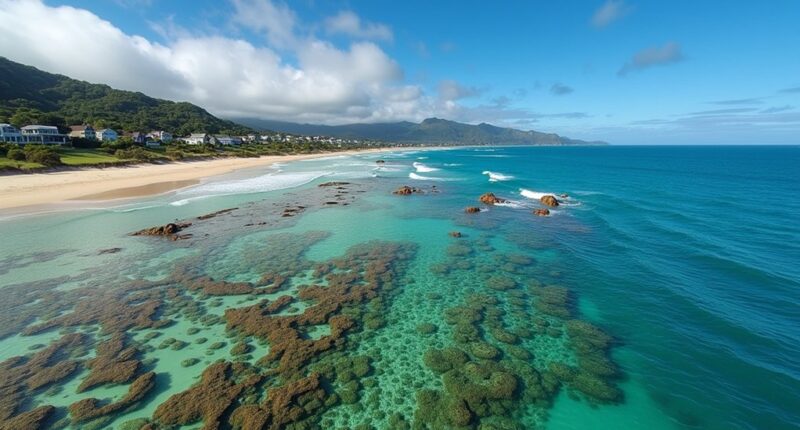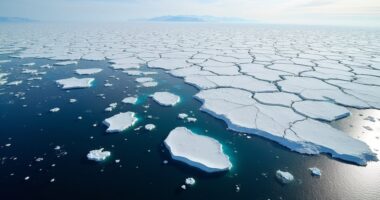A study highlights New Zealand’s coastal regions as hot spots for accelerated ocean warming, revealing alarming risks to homes and fisheries. With ocean temperatures rising faster than the global average, marine heatwaves are reshaping ecosystems and pushing fish to new waters. Vulnerable properties face significant flooding and erosion threats, leading to potential economic fallout. As the sea gets warmer, interactive marine life struggles. To grasp the full picture, moving past the waves of information is essential.
Quick Overview
- Ocean temperatures in New Zealand are rising 34% faster than the global average, posing significant risks to coastal communities and fisheries.
- Marine heatwaves are increasing, leading to severe disruptions in marine habitats and biodiversity, affecting local fish populations.
- Over 1,300 coastal properties in New Zealand are projected to be at risk of significant damage due to rising sea levels and flooding by 2060.
- Economic impacts from flooding and erosion in coastal areas may exceed $1 billion, as property values decline and insurance claims rise.
- Sustainable fisheries management is crucial to mitigate the adverse effects of warming oceans and preserve marine ecosystems in New Zealand.
Accelerated Ocean Temperature Rise and Its Implications
In the grand theater of climate change, New Zealand finds itself in a rather hot seat—quite literally. Ocean temperatures are warming 34% faster than the global average, and as the sea-surface heats up, marine life feels the heat too.
With projections showing an increase of 1.0–3.0°C by century’s end, Kiwis might soon need sunscreen for their fish! Marine heatwaves are becoming frequent, turning once-cool waters into sizzling spas. This shift disrupts habitats, impacting biodiversity and food webs. It’s like a buffet where the menu keeps changing, leaving some species scrambling for their next meal—or in this case, their next habitat! Implementing sustainable fisheries management could help mitigate some of these climate change impacts on marine life. As these marine ecosystems face increased stress, the risks of coastal flooding and erosion also rise, especially for over 219,000 homes located in flood-prone areas.
Coastal Vulnerabilities and Economic Consequences
Coastal vulnerabilities in New Zealand are shaping up to be more than just an environmental concern; they’re the proverbial canary in the coal mine for the economy.
With 219,000 homes worth $180 billion sitting in flood zones, the stakes are high.
219,000 homes valued at $180 billion sit in flood zones, highlighting the urgent need for action.
By 2060, over 1,300 seaside properties could suffer significant damage, while infrastructure valued at $26.18 billion is also at risk. Approximately 1,300 residential properties face over 20 percent damage from extreme events between 2026 and 2060.
Flooding and erosion are no longer rare surprises but regular visitors.
As insurance claims soar and property values plummet, the economic impact could reach over $1 billion for repairs and adaptations, leaving coastal communities in a precarious balance.
Sustainable development of marine resources will be crucial for maintaining New Zealand’s economic resilience while protecting vulnerable coastal areas.
In fact, New Zealand’s oceans are warming 34% faster than the global average, exacerbating these risks.
Impact on Marine Ecosystems and Fisheries
The impact of ocean warming on marine ecosystems and fisheries in New Zealand resembles a dramatic plot twist in a nature documentary, where the characters are struggling to adapt to an ever-changing script. Fish and invertebrates are shifting north and south, while native species face stress and habitat loss, like athletes trying to perform in flip-flops. Invasive species stroll in, keen to outcompete locals, while keystone habitats—think coral reefs and kelp forests—are disappearing faster than a magician’s rabbit. Conservation efforts must focus on ecosystem restoration to preserve the delicate balance of marine biodiversity before it’s too late. As fisheries scramble to keep up with unpredictable stock movements, the balance of marine life hangs by a thread, leaving everyone in a fishy predicament. Additionally, ocean temperatures are increasing, with marine heatwaves becoming more frequent and intense, further complicating the survival of local species. This phenomenon is concerning as New Zealand’s ocean warming is happening faster than the global average, amplifying the challenges faced by marine ecosystems.









